Introduction
A yarn winding machine is a mechanical device used in textile manufacturing to wind yarn onto bobbins, cones, or other types of yarn carriers. In addition to preparing and packaging yarn, it is also used in weaving, knitting, and other textile production processes. A yarn winding machine is used mainly to wind yarns from large packages, such as cones or spools, into smaller, more manageable packages. Textile mills, spinning mills, and yarn manufacturing facilities commonly use yarn winding machines to improve subsequent textile operations’ quality and efficiency. The machine typically has three components: a rotating drum or spindle that holds the yarn package, a traversing mechanism that moves across the drum, and a winding mechanism that winds the yarn onto a smaller package. The winding mechanism may include a tensioning device to ensure the yarn is appropriately tensioned during the winding process. Depending on the yarn being processed, several features and configurations can be used on yarn winding machines. The machines may have features such as adjustable winding speed, yarn tension control, yarn clearing mechanisms to remove defects or knots, and automatic stoppage when the yarn breaks.
Yarn winding machines must be utilized within the textile industry to ensure efficient and accurate yarn packaging for ease of subsequent operations and quality of the final textile product.
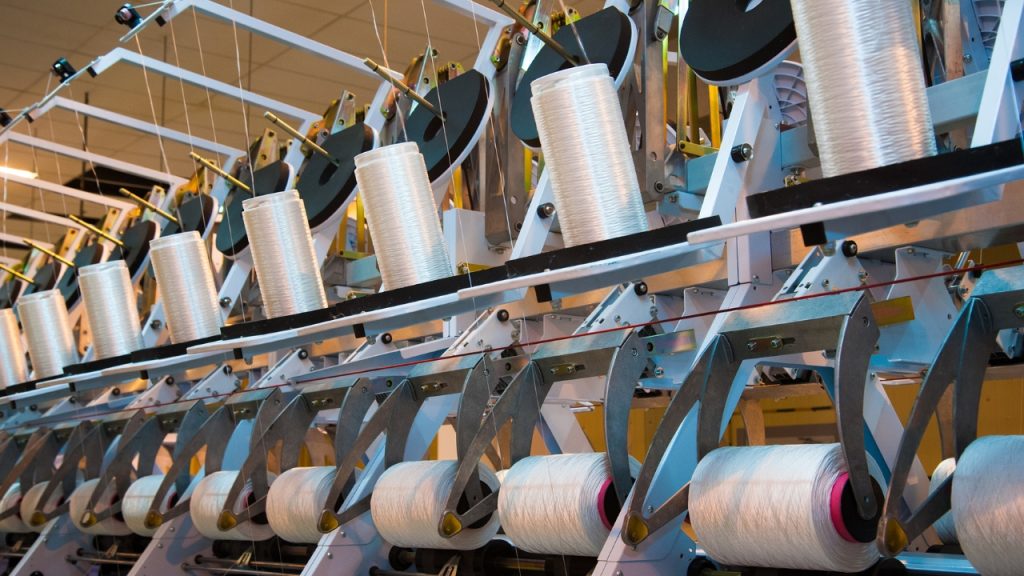
Types of Winding Machine
This is a list of some common types of winding machines that are used in various industries depending on the specific requirements of the material that needs to be incorporated. Here is a list of some common types of winding machine:
1. According to Package
Cop winding machine: A cop winding machine is used in the textile industry to wind yarn onto cops. Cops are cylindrical packages that are commonly used in spinning mills for storage and further processing. It is important to wind yarn efficiently onto cops with cop winding machines, ensuring proper tension and package formation.
Pirn winding machine: In shuttle looms, pirns are cylindrical bobbins holding weft yarn wounds onto pirn winding machines. Pirns are commonly found in the textile industry, particularly in weaving.
Cheese winding machine: It is common to use cheese winding machines in the textile industry to produce large quantities of yarn for industrial applications, and they wind yarn onto cylindrical packages called cheeses. They can handle a wide range of yarn counts with waxing and cone-to-cheese conversion features.
Cone winding machine: In the textile industry, cone winding machines wind yarn onto conical-shaped packages called cones. They are designed to handle high-speed winding and feature features such as automatic cone doffing, yarn-clearing mechanisms, and cone conditioning.
Flanged bobbin winding machine: A flanged bobbin winding machine is a type of winding machine used in the textile industry to wind yarn onto flanged bobbins. The wound yarn is kept in place in flanged bobbins, and the unwinding process is facilitated by flanged ends on both ends.
2. According to Winding
Precision winding machine: Precision yarn winding machines are specialized winding machines that wind yarn precisely onto bobbins, cones, or other types of yarn carriers. Generally, it is used in textiles to prepare yarn for weaving, knitting, or crocheting. In addition to providing accurate winding, consistent tension control, and high-quality yarn packages, precision yarn winding machines offer advanced features and capabilities.
Non-precision winding machine: A non-precision yarn winding machine, also known as a conventional yarn winding machine, is used in the textile industry to wind yarn onto bobbins, cones, or other types of yarn carriers. The design and functionality of non-precision yarn winding machines are relatively more straightforward than those of precision yarn winding machines that offer advanced features for precise and controlled winding.
3. According to Drive
Direct drive winding machine: A direct drive winding machine, also known as a direct drive winder, utilizes a direct drive system for its operation. Direct drive systems eliminate the need for belts, gears, or other intermediate power transmission components by connecting the motor directly to the winding spindle or the main drive shaft.
Indirect drive winding machine: An indirect drive winding machine is a type of winding machine that uses an indirect drive system for its operation. An indirect drive system transfers power from the motor to the winding spindle or main drive shaft through intermediate components such as belts, gears, or pulleys.
4. According Types of Yarn Used
For warp yarn:
- Upright spindle winding machine.
- Drum/Cylinder winding machine.
For weft yarn:
- Ordinary pirn winding machine.
- Automatic pirn winding machine.
- Cop winding machine.
Auxiliary Function of Winding Machine
1. creeling:
The process of creeling involves loading yarn onto a creel, a rack or frame designed to hold multiple yarn packages or cones. Creeling is an essential step in processing yarn for weaving, knitting, or spinning.
2. Piecing:
The term “piecing” in the context of a yarn winding machine refers to the process of joining or connecting the end of one yarn package to the beginning of a new one without interrupting or knotting the yarn during the winding process. In this situation, the current package’s yarn is almost depleted, and a new package must be introduced to continue winding.
3. Doffing:
In a yarn winding machine, doffing is the process of removing the finished yarn package from the winding machine. To allow the winding process to continue, a yarn package must be doffed once it is fully wound. Depending on the type of yarn winding machine, doffing can be done manually or automatically.
Winding efficiency:
A yarn winding machine’s efficiency measures how efficiently it transforms raw yarn material into finished yarn packages while minimizing waste, maximizing output, and optimizing production. The percentage expression of the ratio of the actual production to the calculated production is called winding efficiency. Winding efficiency can be calculated by this formula:
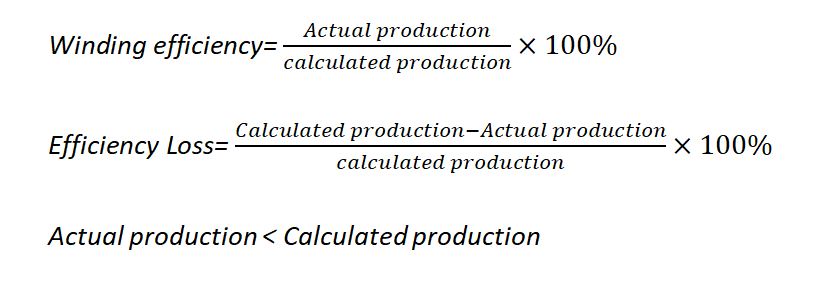
Factors upon which winding efficiency depends
Several factors must be considered for yarn winding to be productive and effective. A yarn-winding process can be affected by a variety of factors, such as the yarn, the winding machine, and the desired output. Here are some of the key factors that influence yarn winding efficiency:
1. Yarn Quality and Characteristics: The quality and characteristics of the yarn being wound impact the efficiency of the process. Winding yarn with consistent properties, minimal defects, and appropriate twist levels is more manageable. If the yarn is prone to breaking, tangling, or varies in thickness, it can decrease efficiency.
2. Operator Skills and Training: The skills and expertise of the operators operating the winding machines can impact efficiency. A properly trained operator is able to optimize the process and identify and resolve issues promptly because they understand the machine’s capabilities, settings, and troubleshooting procedures. The more efficient the work, the more efficient the winding will be.
3. Machine maintenance: Maintaining the winding machine regularly, including cleaning, lubrication, and timely replacement of worn parts, will minimize downtime and maximize productivity. Winding efficiency increases if the machine is maintained and hauled correctly.
4. Spindle speed: Generally, higher spindle speeds increase productivity since more yarn is wound in a shorter period of time. This allows for faster yarn winding and helps meet production targets.
5. Yarn count: When winding thicker yarns, slower speeds are generally necessary to maintain proper tension and prevent breakage. When winding thicker yarns at higher speeds, tension variations, yarn breaks, or tangling can occur, reducing efficiency. In contrast, finer yarns are able to tolerate higher winding speeds, increasing productivity and winding efficiency.
6. Humidity: Depending on the moisture content in the environment, yarn will change in weight and thickness. As yarn is hygroscopic, it can absorb moisture from the atmosphere. High humidity levels can cause yarn to absorb moisture, resulting in an increase in weight and thickness. As a result, yarn length measurements can be inaccurate during winding, potentially resulting in package weight and density variations. So, Humidity is reciprocal or inversely proportional to winding efficiency.
7. Workload per worker: The workload per worker, which refers to the amount of work assigned to each worker, can affect productivity. Workers may feel overwhelmed if the workload is too high, resulting in errors, a lack of focus, and a reduction in yarn winding efficiency. Winding efficiency will increase if the workload on each worker is less.
8. Power failure: There is a significant impact of power failures on yarn winding efficiency. Power failures halt machine operation immediately. Winding machines stop functioning if their power supply is disrupted, resulting in downtime. If the power failure rate increases, the winding efficiency will decrease. This can cause delays in production and decrease efficiency.
9. Creating time: The creeping time, which refers to the time required to load new yarn packages onto the creel of a winding machine, can impact winding efficiency. During the creating of new yarn packages, there is a direct impact on machine downtime. As the winding machine waits for new packages to be loaded onto the creel, it cannot wind further yarn packages. This downtime reduces the efficiency and productivity of the winding process. Creating efficiency decreases with increasing creeping time.
10. Doffing time: During the doffing process, a full package is removed from the winding machine and replaced with an empty package, which can affect yarn winding efficiency. During the doffing process, a temporary pause is used to remove and replace packages. When doffing takes a long time, there will be more downtime, which will reduce machine utilization and productivity. As doffing takes a long time, efficiency will decrease.
11. Capacity utilization: A high capacity utilization of the yarn winding machine ensures that resources, including labor, equipment, and materials, are efficiently used. As the machine’s capacity utilization decreases, efficiency increases. When the machine operates closer to its maximum capacity, the cost per production unit tends to be lower, resulting in improved efficiency.
Driving Methods of Winding Machine
There are many ways to drive a yarn winding machine. The following are a few of the most common methods used:
- Surface contact driving.
- Direct package diving at constant speed.
- Direct package driving at variable speed.
1. Surface contact driving:
Some yarn winding machines use surface contact driving, where the driving force is applied directly to the yarn package or bobbin. The driving force is transmitted through frictional contact between the driving element and the package surface. Motor-driven groove drums are used in this process. Due to the drum’s contact with the package, when the drum rotates, the package also rotates. Grooves in the drum allow the yarn to traverse. With increasing package diameter, the winding rate remains constant.
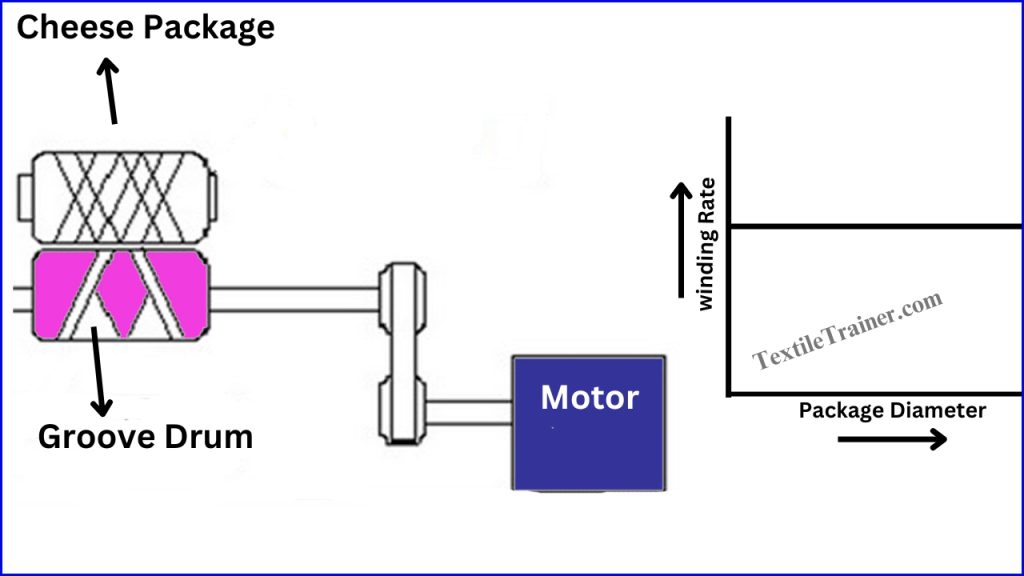
2. Direct package diving at constant speed:
During yarn winding machines, direct package drive at a constant speed involves driving the package or bobbin directly by a motor at a constant speed. This system rotates the spindle with the motor while the yarn package is placed in a spindle. Therefore, the package gets motion directly from the motor. A package gets angular motion, and the yarn take-up rate is proportional to the package diameter.
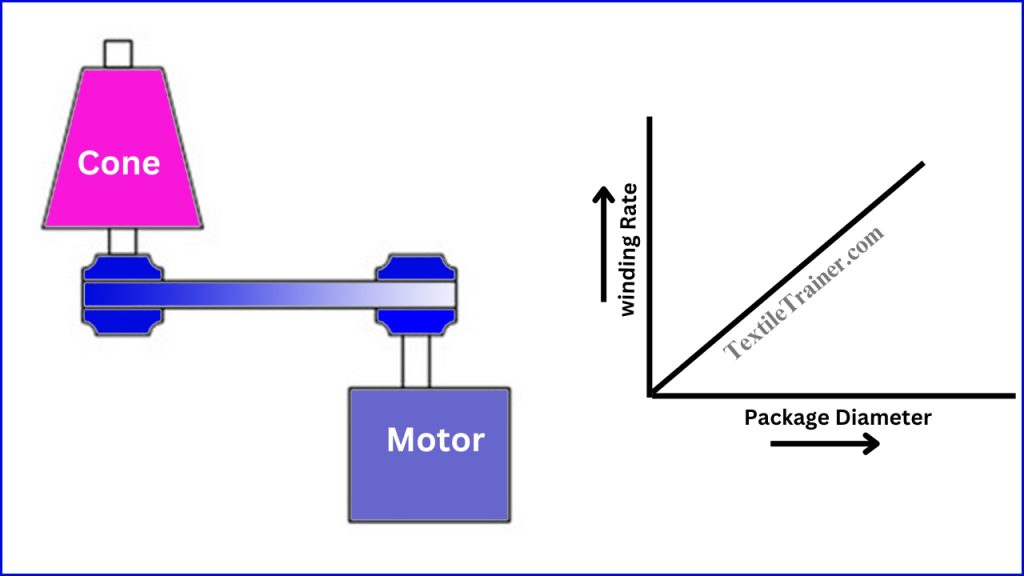
3. Direct package driving at variable speed:
With this system, the yarn package is placed in a spindle, and the spindle is rotated by the motor in order to produce yarn. As a result, the package gets its motion directly from the motor. In this case, the rotational speed of the package is varied inversely to the package diameter to keep the winding speed constant.
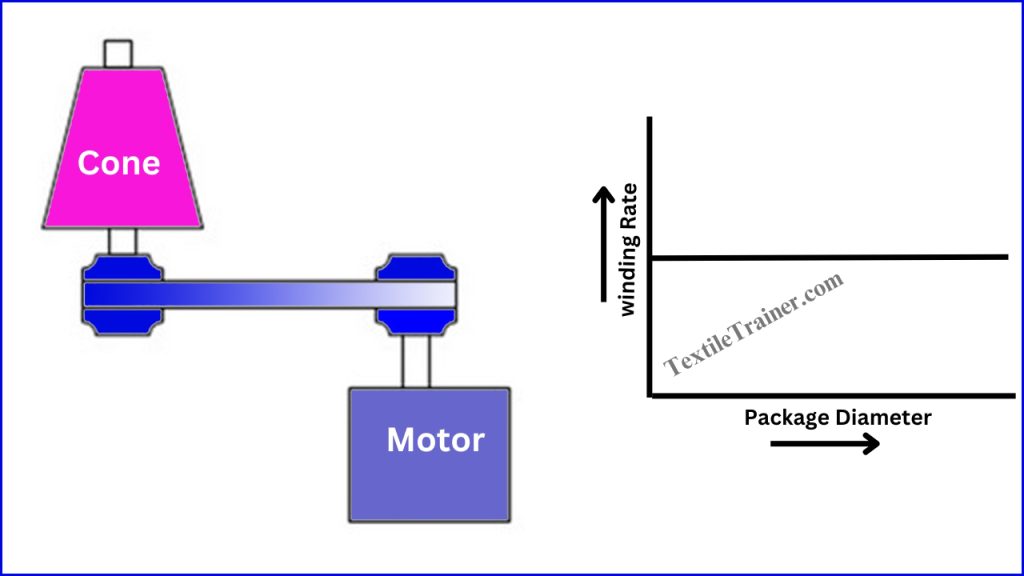
Conclusion:
In the textile industry, yarn winding machines are indispensable tools for winding yarn on bobbins or cones efficiently and precisely. Textile products such as fabrics, garments, and home textiles are manufactured using these machines. Several advantages of yarn winding machines include increased productivity, consistent yarn tension, lower yarn breakage, and better quality control. High-volume production can be met with greater efficiency and efficiency thanks to them. Throughout this article, I wanted to give you a basic understanding of what yarn winding machines are, how they work, and how they are driven. I sincerely thank you for taking the time to stay with me.
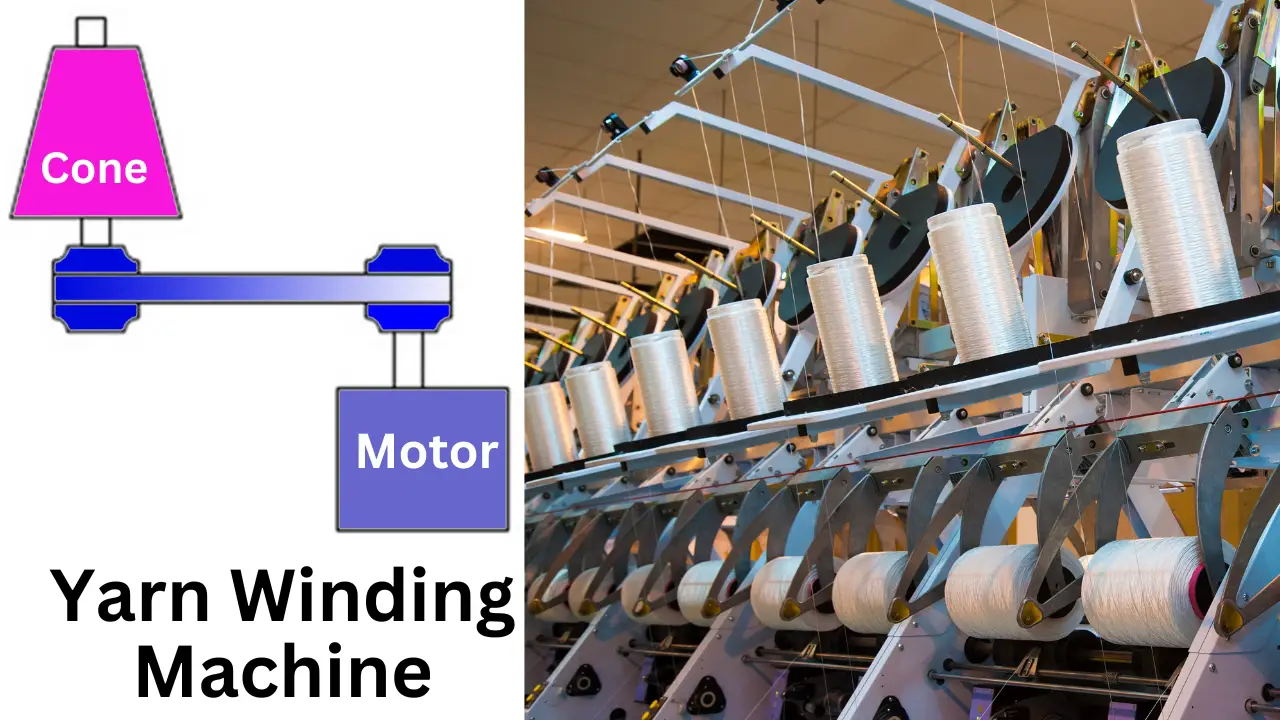

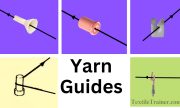

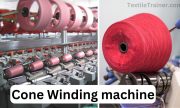
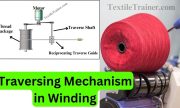

Hey There. I found your blog using msn. This is an extremely well written article. I will be sure to bookmark it and come back to read more of your useful info. Thanks for the post. I’ll definitely comeback.
thank you…
It’s in reality a great and useful piece of info.I am happy that you shared this helpful information with us.Please keep us up to date like this. Thank you for sharing.
thank for comments
I really enjoy the blog post.Much thanks again. Fantastic.
thanks too….
Hey, thanks for the blog article.
Keep visit our site..
Im thankful for the blog article.Much thanks again. Cool.
please support us….
A round of applause for your article.Really thank you! Fantastic.
please support us….
Thanks a lot for the blog post.Much thanks again. Awesome.
thanks too….please support us….
Thank you for your blog post.Really looking forward to read more.
thanks for your comments.
Thanks again for the blog article.Really looking forward to read more. Much obliged.
Thank you dear. Stay with us. Happy reading.
I really like and appreciate your blog post.Really thank you! Really Great.
keep visit our site.
A big thank you for your blog post.Really thank you! Fantastic.
I loved your article post.Really looking forward to read more. Want more.
Very neat blog.Really looking forward to read more. Cool.
Thank you for your article.Thanks Again. Really Cool.
thanks too…
Major thanks for the article post.Really thank you! Really Great.
Welcome
Appreciate you sharing, great blog.Really thank you!
Very good post.Really thank you! Will read on…
keep visit our site….
Thank you for your article post. Great.
Great blog post.Really looking forward to read more. Really Cool.
Fantastic article post.Thanks Again. Keep writing.
Thank you for your article.Thanks Again. Much obliged.
wow, awesome post.Much thanks again. Awesome.
Great, thanks for sharing this blog article.Really thank you! Fantastic.
Hi, just wanted to mention, I enjoyed this blog post.It was helpful. Keep on posting!
This is one awesome article.Thanks Again. Really Great.
I appreciate you sharing this blog post.Really looking forward to read more. Awesome.
I really enjoy the article post.Much thanks again. Cool.
Thank you ever so for you blog article.Really looking forward to read more. Cool.
Thank you for your blog article.Thanks Again. Will read on…
keep visit our site.
Thanks for the blog article.Really looking forward to read more. Really Cool.
keep visit our site.
Thanks so much for the blog.Really looking forward to read more. Keep writing.
keep visit our site.
Thanks for the blog post.Much thanks again. Really Cool.
please support us…..
Im thankful for the article.Really looking forward to read more. Fantastic.
Im thankful for the blog article.Really looking forward to read more. Keep writing.
Thank you ever so for you article post. Cool.
Very informative blog post.Really looking forward to read more. Great.
Really informative blog post.Thanks Again. Will read on…
Thanks a lot for the article post. Awesome.
wow, awesome article.Much thanks again.
I truly appreciate this blog post. Fantastic.
Thanks-a-mundo for the article.Really looking forward to read more.
Thanks
Im grateful for the blog post. Fantastic.
Welcome
Thanks again for the blog.Really thank you!
I really like and appreciate your post.Really looking forward to read more. Much obliged.
Looking forward to reading more. Great blog post.Much thanks again. Cool.
Thanks a lot for the blog.Really thank you! Keep writing.
Fantastic post.Much thanks again. Keep writing.
I appreciate you sharing this blog.Really looking forward to read more.
I think this is a real great article post.Really looking forward to read more.
A round of applause for your blog post.Much thanks again. Great.
Thanks for the blog post.Really looking forward to read more. Want more.
I value the article.Much thanks again. Much obliged.
I really enjoy the article.Much thanks again. Will read on…
Fantastic article.Really looking forward to read more. Fantastic.
Looking forward to reading more. Great blog article. Cool.
Fantastic post.Much thanks again. Really Cool.
I really liked your blog.Thanks Again. Keep writing.
Hey, thanks for the article. Cool.
Enjoyed every bit of your post.Really looking forward to read more. Will read on…
Thanks a lot for the blog post. Fantastic.
Very good blog post.Really thank you! Great.
I appreciate you sharing this article post.Really looking forward to read more. Really Great.
Im grateful for the article post.Much thanks again. Really Great.
I truly appreciate this post.Really looking forward to read more. Will read on…
Im grateful for the article.Much thanks again. Want more.
Thanks a lot for the blog post.Thanks Again. Keep writing.
Say, you got a nice article.Much thanks again. Fantastic.
Looking forward to reading more. Great blog post.Much thanks again. Cool.
Hey, thanks for the blog post.Thanks Again. Cool.
Im grateful for the post.Much thanks again. Great.
Very informative blog post.Really thank you! Fantastic.
Awesome blog. Keep writing.
Great, thanks for sharing this blog. Great.
Thanks too
Hey, thanks for the blog.Really looking forward to read more. Much obliged.
Welcome. Stay connected
Awesome blog post.Thanks Again.
Say, you got a nice post.Really thank you! Cool.
Appreciate you sharing, great blog article.Thanks Again. Want more.
Very neat blog article.Much thanks again. Want more.
I value the article.Really looking forward to read more. Great.
Really enjoyed this blog post.Much thanks again. Cool.
Great, thanks for sharing this blog.Really thank you! Cool.
Thanks again for the post.Thanks Again. Much obliged.
Thanks for sharing, this is a fantastic blog. Really Great.
I really enjoy the blog article.Really thank you!
Thanks so much for the post.Thanks Again. Want more.
Thanks again for the blog.Really thank you! Keep writing.
Really appreciate you sharing this article post. Keep writing.
Say, you got a nice blog article. Will read on…
Major thanks for the blog article.Really thank you! Really Great.
Thank you for your post.Really thank you!
I value the post.Really looking forward to read more. Keep writing.
Say, you got a nice blog article.Much thanks again. Really Great.
Great, thanks for sharing this article.Really looking forward to read more.
Thank you for your blog.Thanks Again. Great.
I loved your article post.Really looking forward to read more. Really Cool.
I really like and appreciate your blog post. Awesome.
I really enjoy the blog article.Much thanks again. Cool.
Really informative post.Really looking forward to read more. Awesome.
Im thankful for the article post.Much thanks again. Really Cool.
Major thankies for the blog.Much thanks again.
A round of applause for your article.
Appreciate you sharing, great blog article. Awesome.
I appreciate you sharing this blog post.Really looking forward to read more. Really Cool.
Enjoyed every bit of your article post. Will read on…
Thanks so much for the blog.Much thanks again. Will read on…
A big thank you for your post.Thanks Again. Want more.
I loved your post.Much thanks again. Keep writing.
I truly appreciate this blog article.Really looking forward to read more. Really Cool.
I loved your post.Much thanks again. Fantastic.
Thanks for sharing, this is a fantastic blog.Really looking forward to read more. Really Cool.
I really liked your blog article.Really looking forward to read more. Will read on…
Say, you got a nice article post.Really looking forward to read more. Great.
Very good blog article.Thanks Again. Cool.
Enjoyed every bit of your blog.Really thank you!
A big thank you for your post.Really looking forward to read more. Cool.
Say, you got a nice article post.Really thank you!
I appreciate you sharing this article post.Really looking forward to read more.
wow, awesome blog post.Really thank you! Keep writing.
Say, you got a nice blog.Thanks Again. Really Cool.
This is one awesome blog post.Thanks Again. Will read on…
I really like and appreciate your post.Really looking forward to read more. Awesome.
Say, you got a nice article post.Thanks Again. Fantastic.
wow, awesome blog article. Keep writing.
I really enjoy the article.Much thanks again. Want more.
I loved your blog article.Much thanks again. Fantastic.
Thank you for your article. Fantastic.
Very good blog post.Really thank you! Cool.
Very informative article. Awesome.
Looking forward to reading more. Great blog post. Want more.
Thanks for the blog. Awesome.
Thanks so much for the post. Want more.
Thanks so much for the post.Really thank you! Awesome.
Very neat post.Really looking forward to read more. Will read on…
new reader. What could you recommend in regards
Thanks
Really informative blog article. Great.
Very good blog post. Much obliged.
Thanks
Thank you ever so for you article.Really looking forward to read more. Cool.
Really informative article post. Keep writing.
This is one awesome blog.Really thank you! Want more.
I really like and appreciate your article.Really looking forward to read more. Keep writing.
Stay connected
Very informative article.Thanks Again. Will read on…
Thanks-a-mundo for the post. Keep writing.
A round of applause for your blog article. Want more.
Thanks
I’ve been surfing on-line greater than 3 hours lately, yet I never found any attention-grabbing article like yours. It?s pretty price sufficient for me. Personally, if all web owners and bloggers made good content as you did, the web will likely be a lot more useful than ever before.
Thanks for revealing your ideas right here. The other factor is that any time a problem occurs with a laptop or computer motherboard, folks should not consider the risk regarding repairing the item themselves because if it is not done properly it can lead to irreparable damage to the whole laptop. It is usually safe just to approach your dealer of the laptop for that repair of that motherboard. They have technicians that have an competence in dealing with notebook computer motherboard problems and can get the right diagnosis and perform repairs.
Thanks
Fantastic blog post.Thanks Again. Great.
Thanks
Thank you for your article.Much thanks again. Will read on…
Thank you for your article.Thanks Again. Awesome.
Very good article post.Thanks Again. Really Great.
I really like and appreciate your blog post. Will read on…
Thanks for sharing, this is a fantastic blog.
I am so grateful for your article.Much thanks again. Much obliged.
Really enjoyed this blog post. Awesome.
Really enjoyed this blog.Thanks Again. Fantastic.
wow, awesome article post. Keep writing.
Thanks again for the post. Want more.
Thanks a lot for the blog.Really thank you! Want more.
I value the post.Thanks Again. Cool.
Very good blog article.Really thank you! Great.
Thank you for your blog.Thanks Again. Fantastic.
Appreciate you sharing, great post.Much thanks again. Cool.
Say, you got a nice article.Really thank you! Awesome.
Great article post.Really thank you! Much obliged.
Enjoyed every bit of your blog.Thanks Again. Want more.
I really enjoy the post.Really looking forward to read more. Really Cool.
Very good article post. Much obliged.
Hello there, just became aware of your blog through Google, and found that it is truly informative. I am gonna watch out for brussels. I will be grateful if you continue this in future. Numerous people will be benefited from your writing. Cheers!
Good article! We will be linking to this great article on our website. Keep up the great writing.
Im thankful for the blog post. Cool.
Really informative blog article.Really looking forward to read more. Great.
Thanks for the blog.Really looking forward to read more. Want more.
Really appreciate you sharing this article post.Much thanks again. Awesome.
Wow, great blog article.Thanks Again. Will read on…
I truly appreciate this blog post.Really thank you! Really Great.
A great post without any doubt.
thnx